
The Prince Albert (PA) is a penis piercing which extends from the urethra to the underside of the glans. It is one of the most common male genital piercings. The related reverse Prince Albert piercing enters through the urethra and exits through a hole pierced in the top of the glans.

A clitoral hood piercing is a female genital piercing through the clitoral hood surrounding the clitoris. In addition to being an adornment, a clitoral hood piercing can enhance sexual pleasure during masturbation, foreplay and intercourse. In an empirical study at the University of South Alabama, the authors reported a positive relationship between vertical clitoral hood piercings and desire, frequency of intercourse, and sexual arousal. There are two main types of clitoral hood piercing: the vertical clitoral hood (VCH) piercing and the horizontal clitoral hood (HCH) piercing. As the names indicate, the difference is in the direction the piercing is oriented in the skin above the clitoris. Neither of these piercings penetrates the clitoris itself, although in common parlance they are sometimes called "clit" piercings. The deep hood piercing is a variation of the clitoral hood piercing that passes deeper through the clitoral hood.

An earring is a piece of jewelry attached to the ear via a piercing in the earlobe or another external part of the ear, or, less often, by some other means. Earrings have been worn in diverse civilizations and historic periods, often carrying a cultural significance.
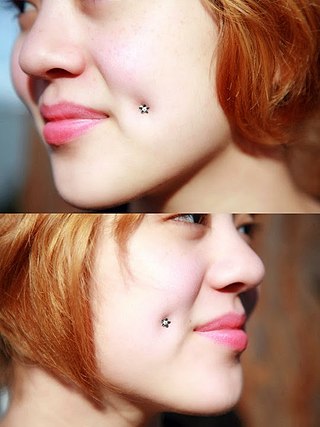
Cheek piercing is a facial body piercing through the cheek. The most common variation of the cheek piercing penetrates the facial tissue into the oral cavity. The usual placement is symmetrical on either side of the face, either penetrating or imitating dimples.

A frenum piercing is a type of body piercing located on the underside of the shaft of the penis. A series of parallel frenum piercings is known as a frenum ladder. A frenum ladder may be extended to include lorum piercings, hafada piercings and guiche piercings.

A dydoe is a type of male genital piercing that passes through the ridge of the glans on the head of the penis. They are often done in pairs. Less often, a "king's crown" is where several dydoes are placed around the head of the penis. The jewelry is usually a 12 gauge, straight barbell with a ball on either end, although a ring may be used at a higher chance of rejection. A deep dydoe is one that uses a longer barbell and exits near the tip of the penis.

The palang or ampallang is a male genital piercing that penetrates horizontally through the entire glans of the penis.

Genital piercing is a form of body piercing that involves piercing a part of the genitalia, thus creating a suitable place for wearing different types of jewellery. Nevertheless, the term may also be used pars pro toto to indicate all body piercings in the area of the anus, perineum, penis, scrotum, and vulva, including piercings such as anal, guiche, and pubic that do not involve perforation of genitalia. Genital piercings can be done regardless of sex, with various forms of piercings available. The main motive is beautification and individualization; in addition, some piercings enhance sexual pleasure by increasing stimulation. Pre-modern genital piercings is most culturally widespread in Southeast Asia, where it has been part of traditional practice since ancient times. Records of genital piercing are found in the Kama Sutra.

A hafada piercing is a surface piercing anywhere on the skin of the scrotum. Piercings on the scrotal raphe or "seam" of the scrotum are common. This piercing does not penetrate deep into the scrotum, and due to the looseness and flexibility of the skin in that area, does not migrate or reject as much as many other surface piercings. The main motives are beautification and individualization. A piercing that passes through the scrotum, from front-to-back, or from side-to-side, is known as a transscrotal piercing. Multiple hafada piercings are not uncommon, often as an extension of a frenum ladder or Jacob's Ladder, which is a series of piercings from the frenulum to the scrotum.

A transscrotal piercing is a body piercing that travels through the scrotum from front to back, or from side to side. It is a high risk procedure.
Body piercing jewelry is jewelry manufactured specifically for use in body piercing. The jewelry involved in the art of body piercing comes in a wide variety of shapes and sizes in order to best fit the pierced site. Jewelry may be worn for fashion, cultural tradition, religious beliefs, personal symbolism, and many other reasons.
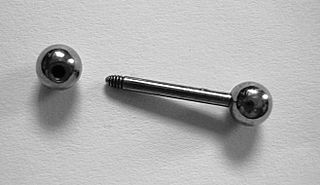
Barbell style piercing jewelry is composed of a straight bar with a bead on each end, one or both beads unscrewable for removal and/or changing of the beads. Often one of the beads is fixed, either via epoxy or welding, so that only one bead is used to install or remove the jewelry. Barbell threads are usually right-handed.

A guiche piercing is a body piercing through the perineum. Guiche piercings are much more common in men than in women. Although a guiche normally runs perpendicular to the direction of the penis, lateral placements are possible. A series of guiche piercings in parallel to the direction of the penis is called a guiche ladder, and might commonly be seen as an extension of a frenum ladder.

A clitoris piercing is a genital piercing placed directly through the head (glans) of the clitoris itself. It is a relatively uncommon piercing by choice because of the potential for nerve damage, and because many may find it too stimulating to allow the constant wearing of a small ring or barbell. Most piercing studios will refuse to do a clitoral piercing. It is often confused with the more common clitoral hood piercing, which pierces only the hood covering the clitoral glans, allowing the jewelry to make only occasional contact with the most sensitive area.
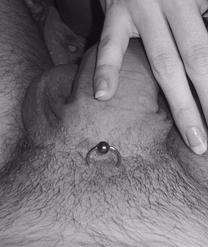
A pubic piercing is a body piercing in the pubic area, on the mons pubis in females, or at the base of the penis in males. Healing times are at around 3–4 months. The rejection rate is around the same as well - that is, higher than most "conventional" piercings, because it is a surface piercing. Some get this piercing because it can offer direct stimulation to the clitoris during intercourse. The placement is at the bottom of the pubic mound just above the penile shaft. Usually, the jewelry inserted is a custom-made surface bar, used to give the best chance of healing.

Foreskin piercing is a piercing that passes through the foreskin of the penis. It is the male equivalent of a clitoral hood piercing in females.

A philtrum piercing, nicknamed a medusa piercing, is an upper lip piercing placed in the philtrum, directly under the septum of the nose. It is typically pierced using a labret stud as jewelry, with the ball sitting outside the mouth in the dip of the top lip.

In body modification, an implant is a device that is placed under the human skin for decorative purposes. Such implants may be subdermal or transdermal. In the context of body modification, some may consider injections of silicone and other substances a type of implant as well.
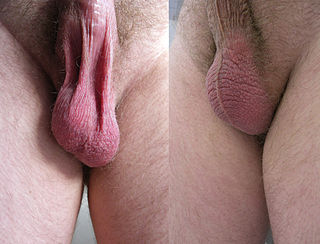
In most terrestrial mammals, the scrotum or scrotal sac is a part of the external male genitalia located at the base of the penis. It consists of a sac of skin containing the external spermatic fascia, testicles, epididymides, and vasa deferentia. The scrotum will usually tighten when exposed to cold temperatures.
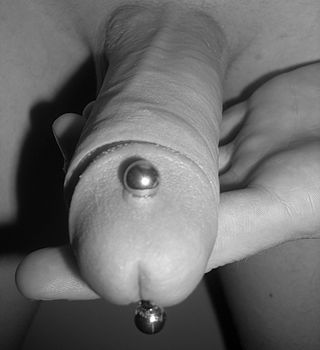
The apadravya, like the ampallang, is a genital piercing that passes through the glans. While the ampallang passes horizontally through the glans, the apadravya passes vertically through the glans from top to bottom, almost always placed centrally and passing through the urethra. It can be paired with an ampallang to form the magic cross. Off-center apadravyas are also possible, wherein the piercing is deliberately offset, yet usually still passes through the urethra. The piercing is often done on a slightly forward angle to the hips.



















